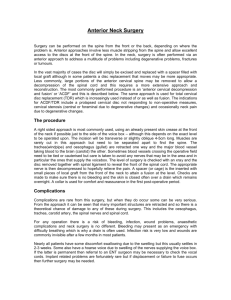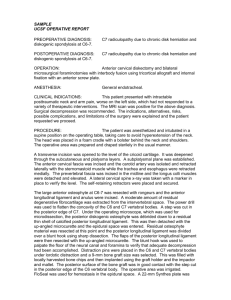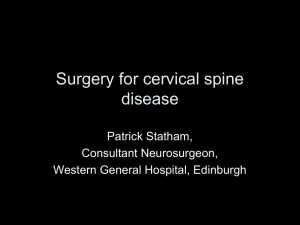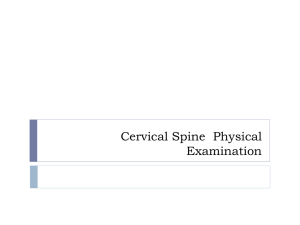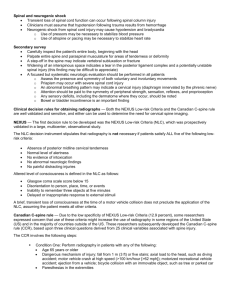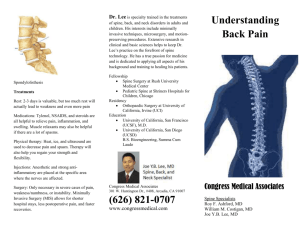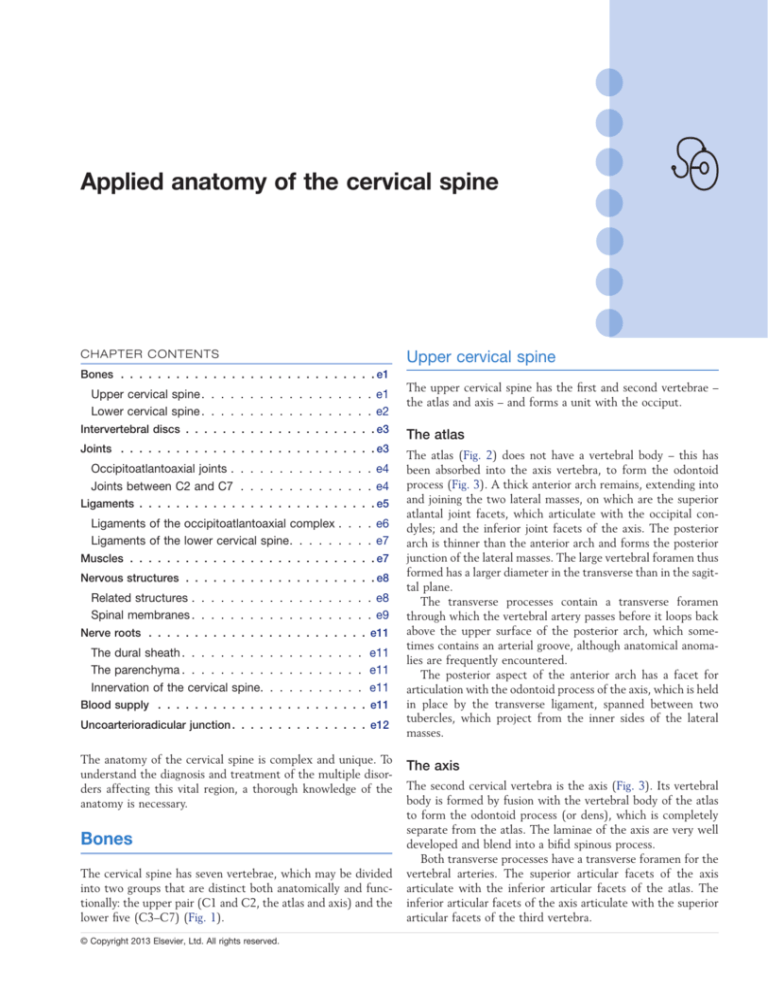
Applied anatomy of the cervical spine Upper cervical spine
CHAPTER CONTENTS
Bones . . . . . . . . . . . . . . . . . . . . . . . . . . . . e1
Upper cervical spine . . . . . . . . . . . . . . . . . . e1
Lower cervical spine . . . . . . . . . . . . . . . . . . e2
Intervertebral discs . . . . . . . . . . . . . . . . . . . . . e3
Joints . . . . . . . . . . . . . . . . . . . . . . . . . . . . e3
Occipitoatlantoaxial joints . . . . . . . . . . . . . . . e4
Joints between C2 and C7 . . . . . . . . . . . . . . e4
Ligaments . . . . . . . . . . . . . . . . . . . . . . . . . . e5
Ligaments of the occipitoatlantoaxial complex . . . . e6
Ligaments of the lower cervical spine . . . . . . . . . e7
Muscles . . . . . . . . . . . . . . . . . . . . . . . . . . . e7
Nervous structures . . . . . . . . . . . . . . . . . . . . . e8
Related structures . . . . . . . . . . . . . . . . . . . e8
Spinal membranes . . . . . . . . . . . . . . . . . . . e9
Nerve roots . . . . . . . . . . . . . . . . . . . . . . . .
e11
The dural sheath . . . . . . . . . . . . . . . . . . . e11
The parenchyma . . . . . . . . . . . . . . . . . . . e11
Innervation of the cervical spine . . . . . . . . . . . e11
Blood supply . . . . . . . . . . . . . . . . . . . . . . .
e11
Uncoarterioradicular junction . . . . . . . . . . . . . . . e12
The anatomy of the cervical spine is complex and unique. To
understand the diagnosis and treatment of the multiple disorders affecting this vital region, a thorough knowledge of the
anatomy is necessary.
Bones
The cervical spine has seven vertebrae, which may be divided
into two groups that are distinct both anatomically and functionally: the upper pair (C1 and C2, the atlas and axis) and the
lower five (C3–C7) (Fig. 1).
© Copyright 2013 Elsevier, Ltd. All rights reserved.
The upper cervical spine has the first and second vertebrae –
the atlas and axis – and forms a unit with the occiput.
The atlas
The atlas (Fig. 2) does not have a vertebral body – this has
been absorbed into the axis vertebra, to form the odontoid
process (Fig. 3). A thick anterior arch remains, extending into
and joining the two lateral masses, on which are the superior
atlantal joint facets, which articulate with the occipital condyles; and the inferior joint facets of the axis. The posterior
arch is thinner than the anterior arch and forms the posterior
junction of the lateral masses. The large vertebral foramen thus
formed has a larger diameter in the transverse than in the sagittal plane.
The transverse processes contain a transverse foramen
through which the vertebral artery passes before it loops back
above the upper surface of the posterior arch, which sometimes contains an arterial groove, although anatomical anomalies are frequently encountered.
The posterior aspect of the anterior arch has a facet for
articulation with the odontoid process of the axis, which is held
in place by the transverse ligament, spanned between two
tubercles, which project from the inner sides of the lateral
masses.
The axis
The second cervical vertebra is the axis (Fig. 3). Its vertebral
body is formed by fusion with the vertebral body of the atlas
to form the odontoid process (or dens), which is completely
separate from the atlas. The laminae of the axis are very well
developed and blend into a bifid spinous process.
Both transverse processes have a transverse foramen for the
vertebral arteries. The superior articular facets of the axis
articulate with the inferior articular facets of the atlas. The
inferior articular facets of the axis articulate with the superior
articular facets of the third vertebra.
The Cervical Spine
Anterior tubercle
Atlas
7
1
2
3
4
8
Dens (root)
Axis
5
9
Intervertebral
foramen
10
Down-turned
ventral lip
11
Raised lateral
lip of body
Uncinate process
3rd to 7th
cervical
vertebrae
Carotid tubercle 6
Transverse A
process
1
Costal element 2
3
Fig 1 • Anterior view of the cervical spine. From Standring, Gray’s
Anatomy, 40th edn. Churchill Livingstone/Elsevier, Philadelphia, 2009 with
4
permission.
9
10
5
6
1
2
8
3
4
9
5
6
7
Fig 2 • The atlas, superior view. 1, Anterior tubercle; 2, anterior
arch; 3, outline of the dens; 4, superior articular facet; 5, outline
of transverse ligament; 6, groove for cervical artery and C1;
7, posterior arch; 8, transverse process; 9, foramen transversum;
10, vertebral foramen; 11, posterior tubercle. From Standring, Gray’s
11
8
B
12
Fig 3 • (A) Axis, superior view. 1, Dens – attachment of apical
ligaments; 2, superior articular facet; 3, dens – attachment of alar
10
ligaments; 4, foramen transversum; 5, pedicle; 6, spinous process;
11
7, body; 8, transverse process; 9, vertebral foramen; 10, inferior
articular process; 11, lamina. (B) Axis, lateral aspect. 1, Dens
– attachment of alar ligaments; 2, dens – facet for the anterior arch
of the atlas; 3, groove for transverse ligament of atlas; 4, superior
articular facet; 5, lateral mass; 6, divergent foramen transversum;
7, body; 8, ventral lip of body; 9, lamina; 10, spinous process;
11, inferior articular facet; 12, transverse process. From Standring,
Anatomy, 40th edn. Churchill Livingstone/Elsevier, Philadelphia, 2009 with
permission.
Lower cervical spine
The lower cervical spine is composed of the third to the seventh
vertebrae which are all very similar. Each vertebral body is quite
small (Fig. 4). Its height is greater posteriorly than anteriorly
and it is concave on its upper aspect and convex on its lower.
On its upper margin it is lipped by a raised edge of bone. The
e2
7
Gray’s Anatomy, 40th edn. Churchill Livingstone/Elsevier, Philadelphia, 2009 with
permission.
anteroinferior border of the vertebral body projects over the
anterosuperior border of the lower vertebra.
Anterolateral (in the upper vertebrae) to posterolateral (in
the lower vertebrae) on the upper surface of the body, two
uncinate processes project upwards and articulate with the
lower notches (or anvils) of the upper vertebra to form the
joints of von Luschka or uncovertebral joints.
Laterally, the transverse processes have an anterior and a
posterior tubercle, which are respectively the remnants of an
embryonic rib and transverse process. The spinal nerve lies in
© Copyright 2013 Elsevier, Ltd. All rights reserved.
Applied anatomy of the cervical spine 5
6
1
7
8
2
9
3
10
4
Fig 4 • Seventh cervical vertebra, superior view. 1, Body;
2, superior articular process; 3, inferior articular process; 4, spinous
process; 5, uncinate process; 6, foramen transversum;
7, transverse process; 8, pedicle; 9, vertebral foramen; 10, lamina.
From Standring, Gray’s Anatomy, 40th edn. Churchill Livingstone/Elsevier,
Philadelphia, 2009 with permission.
Fig 5 • The intervertebral discs.
the groove between the two tubercles. The transverse process
also has a transverse foramen for the vertebral artery and vein.
This is not so at C7, where the foramen encloses only the
accessory vertebral vein.
The intervertebral foramina are between the superior and
inferior pedicles. The articular processes for the articulation
with the other vertebrae are more posterior. The two laminae
blend together in a bifid spinous process (at C3, C4 and C5).
The spinous processes of C6 and C7 are longer and taper
off towards the ends. C7 has a large spinous process and is,
therefore, called the vertebra prominens.
Intervertebral discs
There are six cervical discs, because there is no disc between
the upper two joints. The first disc is between the axis (C2)
and C3. From this level downwards to the C7–T1 joint they
link together and separate the vertebral bodies. Each is named
after the vertebra that lies above: e.g. the C4 disc is the disc
between the C4 and C5 vertebrae (Fig. 5).
The disc, comprised of an annulus fibrosus, a nucleus pulposus and two cartilaginous endplates, has the same functions
as the lumbar disc, and so will not be discussed in detail (see
Ch. 31, Applied Anatomy of the Lumbar Spine). There are,
however, some differences (Table 1). At the cervical spine the
discs are more effectively within the spine than they are at the
thoracic or lumbar levels because of the superior concavity and
inferior convexity of each vertebral body. They are also about
one-third thicker anteriorly than posteriorly, which gives the
cervical spine a lordotic curve that is not related to the shape
of the vertebral bodies. The annulus fibrosus is also thicker in
its posterior part than it is in the lumbar spine. The further
down the spine, the more the nucleus pulposus lies anteriorly
in the disc, and it disappears earlier in life than it does in the
© Copyright 2013 Elsevier, Ltd. All rights reserved.
1
2
3
Fig 6 • The occipitoatlantoaxial joint complex: 1, occiput; 2, atlas;
3, axis.
Table 1 Differences between the cervical and lumbar discs
Cervical
Lumbar
Contained by vertebral bodies
Not contained by vertebral bodies
Thicker anteriorly than posteriorly
Equal height
Annulus thicker posteriorly
Annulus weaker posteriorly
Nucleus in anterior part of disc
Nucleus in posterior part of disc
lumbar spine. For both these reasons, nuclear disc prolapses
are uncommon after the age of 30.
Joints
The cervical spine is more mobile than the thoracic or lumbar.
Its structure allows movements in all directions, although not
every level contributes to all movements.
e3
The Cervical Spine
(a)
(b)
Fig 8 • The occipitoatlantoaxial joint and its rotation.
At the joint between C1 and C2 extensive rotation movement is possible (45–50°) which represents about 50% of rotation in the neck (Fig. 8). There is a moderate flexion–extension
excursion (10°) but lateral flexion is impossible.
Joints between C2 and C7
(c)
Most flexion–extension takes place at the joints C3–C4, C4–
C5 and especially C5–C6. Lateral flexion and axial rotation
occur mainly at C2–C3, C3–C4, C4–C5.
Mobility is less in the most caudal segments and coupling
of movements is present (Fig. 9a). This phenomenon is the
result of the position of the articular surfaces of the facet joints
(see p. 123). Lateral flexion is always combined with ipsilateral
rotation. So, for example, lateral flexion to the left is accompanied by rotation to the left. This is greatest at C2–C3 and
coupling rotation decreases towards the caudal aspect of the
spine. The clinical importance of this becomes clear during
examination: specific articular patterns may occur as its result.
Movement takes place at two sites. First, in the anterior part
of the lower cervical spine, which contains the intervertebral
joints (with their intervertebral discs) and the uncovertebral
joints and, second, in the posterior part where the facet joints,
the arches and the transverse and spinous processes are found.
Anterior aspect
Intervertebral joints
Occipitoatlantoaxial joints
The intervertebral joint is the complex of two vertebral bodies
and the intervertebral disc between them (Fig. 10). The disc
has several functions: it permits greater mobility between the
vertebrae; it helps distribute weight over the surface of the
vertebral body during flexion movements; and it acts as a shock
absorber during axial loading. The joints are mainly stabilized
by the anterior and posterior longitudinal ligaments and the
uncovertebral joints.
The occipital condyles are arcuate in the sagittal plane and fit
into the cup-shaped superior articular surfaces of the atlas (Fig.
6). These joints only allow moderate flexion–extension (13–
15°) and lateral flexion (3–8°) movements (Fig. 7). Axial rotation is not possible at these joints.
Uncovertebral joints (Fig. 11)
These develop during childhood when fissuring occurs in the
lateral aspect of the intervertebral disc, leading to the formation of a cleft in the adult spine. They do not contain articular
cartilage or synovial fluid and must therefore be considered as
Fig 7 • The occipitoatlantoaxial joint and its movements: (a) flexion,
(b) extension, (c) lateral flexion.
e4
© Copyright 2013 Elsevier, Ltd. All rights reserved.
Applied anatomy of the cervical spine (a)
Fig 10 • The intervertebral joint (coloured).
Fig 11 • The uncovertebral joint (boxed).
pseudojoints, although they do undergo degenerative changes.
These secondary ‘joints’ add to lateral stability.
(b)
Posterior aspect and facet joints
Posteriorly the vertebrae are held together by the ligaments
between the spinous processes (ligamentum nuchae and interspinous ligaments) and between the laminae (ligamentum
flavum), and they articulate via the facet joints.
The facet joints are classified as diarthrodial joints: the
articular surfaces are covered with cartilage; there is a synovial
membrane and a fibrous joint capsule with contained synovial
fluid. The joint line is oblique: it courses from anterosuperior
to posteroinferior, along an angle of 45° at the level C2–C3,
which decreases to 10° at C7–T1 (Fig. 12). Because the joint
line is oblique and the capsule is lax, more movement is possible than at the thoracic and lumbar levels.
Rotation is always combined with ipsilateral side flexion.
During rotation to the left the lower facet of the upper vertebra at the left side glides backward on the upper facet of the
vertebra below. The opposite happens at the right.
During extension of the neck, the vertebral body of the
upper vertebra glides backwards (Fig. 13a). The lower facets
not only glide backwards and downwards but also tilt backwards, which results in opening in front and closing behind. The
reverse happens during flexion: the lower facets of the upper
vertebra glide forwards and upwards and tilt forwards, which
opens the joint at the back and closes it in front (Fig. 13c).
Ligaments
Fig 9 • Combined flexion and rotation in the lower cervical spine
(a), and lateral view of disc movements (b), upper: extension;
middle: neutral position; lower: flexion.
© Copyright 2013 Elsevier, Ltd. All rights reserved.
The cervical spine has a complex ligamentous system. Ligament function is to maintain normal osseous relationships.
e5
The Cervical Spine
Clinically, however, they are not so important because ligamentous lesions in the cervical spine are not that common and,
when they occur, it is difficult to find out where exactly the
problem lies.
Two distinct sets of ligaments can be recognized: the ligaments of the occipitoatlantoaxial complex and those of the
lower cervical spine.
Ligaments of the occipitoatlantoaxial
complex
These are strong structures that stabilize the upper cervical
spine. First, there are the ligaments connecting the occiput to
atlas and axis: the anterior atlanto-occipital membrane, the
posterior atlanto-occipital membrane and the tectorial membrane (Fig. 14). A second ligamentous complex connects the
External occipital protuberance
Occipital bone
Posterior
atlanto-occipital
membrane
Articular
capsule of left
atlantooccipital joint
T1
Fig 12 • The facet joints, showing the decrease of the obliquity of
the joint line towards the lower part of the spine.
Arch which covers
vertebral artery, veins
and first cervical
spinal nerve
Atlas, posterior arch
Ligamentum flavum
Articular capsule of
right atlanto-axial joint
Axis, spine
(a)
Posterior atlanto-occipital membrane
Foramen magnum,
posterior border
Temporal bone, petrous part
Internal acoustic meatus
Occipital bone, basilar part
Membrana tectoria
Anterior atlanto-occipital
membrane
Apical ligament of dens
Superior longitudinal band
of cruciform ligament
Atlas, anterior arch
(b)
Vertebral artery
First cervical nerve
Dens
Bursal space in fibrocartilage
Remains of intervertebral disc
Atlas, posterior arch
Transverse ligament
of atlas
(c)
Inferior longitudinal band
of cruciform ligament
Axis, body
Ligamentum flavum
Posterior longitudinal
ligament
Anterior longitudinal
ligament
Fig 13 • Movements at the facet joints: (a) extension, (b) neutral, (c)
flexion.
e6
Fig 14 • Occipitoantlantoaxial complex: posterior view and
sagittal section. From Standring, Gray’s Anatomy, 40th edn. Churchill
Livingstone/Elsevier, Philadelphia, 2009 with permission.
© Copyright 2013 Elsevier, Ltd. All rights reserved.
Applied anatomy of the cervical spine axis to the occiput: the apical ligament, the longitudinal component of the cruciform ligament and the alar ligaments (Fig.
15). Third, there is the complex of ligaments that connect axis
to atlas: the lateral component of the cruciform ligament (the
transverse ligament), the two accessory atlantoaxial ligaments
and the ligamentum flavum (Fig. 16). Finally, the ligamentum
nuchae (Fig. 17) is attached above to the external occipital
protuberance, lies in the sagittal plane and merges with the
1
3
2
interspinous ligaments and supraspinous ligament, which
becomes an individual ligament from the spinous process of
C7 downwards. This ligament contains much elastic tissue and
is stretched during neck flexion. Because of its elasticity it
helps to bring the head back into the neutral position.
Ligaments of the lower cervical spine
The anterior longitudinal ligament (Fig. 18) is closely attached
to the vertebral bodies, but not to the discs. By contrast the
posterior longitudinal ligament (Fig. 19) is firmly attached to
the disc and is wider in the upper cervical spine than in the
lower. Both ligaments are very strong stabilizers of the intervertebral joints. The lateral and posterior bony elements are connected by the ligamentum flavum, the intertransverse ligaments
and interspinous ligaments and the supraspinous ligament
(Fig. 20).
Muscles
Fig 15 • The occipitoaxial ligaments: 1, apical ligament; 2,
cruciform ligament; 3, alar ligament.
Muscular action at the cervical spine is dependent on a combination of activities of a great number of muscles and whether
or not they contract bilaterally or unilaterally. There are three
functional groups: flexors; extensors; and rotators and lateral
flexors.
1
2
3
1
Fig 16 • The atlantoaxial ligaments: (blue) cruciform ligament:
1, longitudinal component; 2, lateral component (= transverse
ligament); 3, accessory atlantoaxial ligaments; (gray) ligamentum
flavum.
Fig 18 • The anterior longitudinal ligament.
ligamentum
nuchae
Fig 17 • The ligamentum nuchae.
© Copyright 2013 Elsevier, Ltd. All rights reserved.
Fig 19 • The posterior longitudinal ligament (posterior view).
e7
The Cervical Spine
3
C7
3
1
1
1
T1
T2
2
2
Fig 20 • The supraspinous (1), interspinous (2) and intertransverse
(3) ligaments.
Most muscles do not have clinical importance, in that lesions
of them hardly ever occur. However, they can sometimes indirectly involve other (non-contractile) structures. On examination a resisted movement (muscular contraction) or a passive
movement (whereby the muscle is stretched) may influence a
lesion lying outside the muscle in, for example, an inert tissue.
One contractile structure makes an exception however: an
acute lesion of the longus colli causes, besides pain and weakness on flexion, serious limitations of extension and both rotations (see Standring, Fig. 28.6).
It should be noted that the function of many of the muscles
is multiple and depends on the mode of action employed.
For example, bilateral action of the sternocleidomastoids
is involved in flexion–extension, but unilateral action results
in ipsilateral lateral flexion and contralateral rotation (see
Fig. 24).
Unilateral action of the flexors results in either pure rotation
or lateral flexion, or a combination of both, sometimes ipsilaterally and sometimes contralaterally.
Many of the extensor muscles have other functions as
well as extension, the latter occurring when they act
bilaterally.
The muscles of the neck are illustrated in Figures 21–24.
Fig 21 • Flexor muscles: 1, scalenes; 2, longus colli; 3; longus
capitis.
4
2
1
3
Fig 22 • Superficial extensor muscles: 1, trapezius; 2, levator
scapulae; 3, splenius cervicis; 4, splenius capitis.
Related structures
increases it and extension decreases it. During extension there
is a backward movement of the upper vertebra in relation to
the lower because of the obliquity of the facet joints (Fig. 13).
As the anteroposterior diameter of the spinal cord at midcervical level is about 10 mm, there is, however, a large margin of
safety.
Spinal canal
Intervertebral foramen
In the cervical spine, the spinal canal is commodious compared
to that of the thoracic and lumbar spine. Its outline is oval
in the transverse plane and the average anteroposterior diameter is 17 mm, although this varies with movement: flexion
The intervertebral foramen lies between adjacent pedicles and
through it the spinal nerve emerges from the spinal canal (Fig.
25). The foramen continues across the bifid transverse process
and is orientated anterolaterally 45° and anterocaudally 15°.
Nervous structures
e8
© Copyright 2013 Elsevier, Ltd. All rights reserved.
Applied anatomy of the cervical spine 7
1
6
5
4
2
3
4
1
s m
Fig 23 • Deep extensor muscles: 1, longissimus capitis; 2,
semispinalis capitis; 3, spinalis cervicis; 4, multifidus; 5, longissimus
cervicis; 6, iliocostalis cervicis; 7, suboccipital complex.
2
3
Fig 25 • The intervertebral foramen: s, sensory fibres; m, motor
fibres. 1, articular facet; 2, vertebral body; 3, uncinate process; 4,
dural sleeve.
between. The arachnoid is a membrane which lies in close
contact with the dura. The subarachnoid space is quite wide.
The third layer, the pia mater, covers the spinal cord (Fig. 26).
A number of dentate ligaments pass between a fold of the pia
mater which extends longitudinally and the anterior and posterior nerve roots. These ligaments are attached to the dura
and suspend the spinal cord in the cerebrospinal fluid.
Mobility of the dura mater
Fig 24 • Functions of the sternocleidomastoids.
The anterior border is the uncinate process and vertebral body
and the articular facet is posterior. The diameter of the foramen
is reduced during a combined movement of extension and
ipsilateral rotation.
Spinal membranes
The dura mater is firmly attached to the rim of the foramen
magnum and its fibres blend with the periosteum within the
skull. In the spinal canal it is not attached to the vertebral
arches, because of the presence of protective fat tissue in
© Copyright 2013 Elsevier, Ltd. All rights reserved.
The dura mater can move considerably without influence on
the cord. This is an interesting feature, in that the cervical
spine lengthens approximately 3 cm during neck flexion. Consequently the dura mater, attached above and below, migrates
within the spinal canal. It thus moves forwards and can be
dragged against any space-occupying lesion within the canal
(e.g. a disc protrusion). As a consequence the mobility of the
dura can be hindered, increasing tension and resulting in pain,
because the dura is also sensitive.
Sensitivity of the dura mater
The anterior aspect of the dura mater is innervated by a dense
longitudinally orientated nerve plexus consisting of different
fibres of the sinuvertebral nerves originating at several levels
(Fig. 27). Distal to the spinal ganglion, the sinuvertebral nerve
detaches and passes back into the spinal canal to innervate
the posterior longitudinal ligament, the anterior aspect of the
dural sac and the dural sheath around the nerve root,
the anterior capsule of the facet joints and also the vascular
structures (Fig. 28).
e9
The Cervical Spine
Trunk of spinal nerve, ramus communicans
Trunk of spinal nerve, anterior branch
Spinal sensory ganglion
Epineurium
Trunk of spinal nerve, posterior branch
Spinal dura mater
Spinal sensory ganglion
Spinal nerve, anterior root
Trunk of spinal nerve, meningeal branch
Denticulate ligament
Spinal nerve, posterior root
Subarachnoid space
Spinal pia mater
(Subdural space)
Spinal dura mater
Spinal arachnoid mater
Epidural space; posterior internal
vertebral venous plexus
Periosteum
Fig 26 • The dura mater and exits from the spinal canal; cross-section at the level of the fifth cervical vertebra. From Putz, Sobotta – Atlas of
Human Anatomy, 14th edn. Urban & Fischer/Elsevier, Munich, 2008 with permission.
1
2
2
3
9
4
1
8
7
3
5
6
4
5
Fig 27 • The sinuvertebral nerve and its related structures:
1, anterior longitudinal ligament; 2, sympathetic trunk; 3, rami
communicantes; 4, ventral ramus of spinal nerve; 5, dorsal ramus
of spinal nerve; 6, posterior longitudinal ligament; 7, spinal ganglion;
8, anterior root; 9, sinuvertebral nerve.
e10
Fig 28 • The anterior part of the dura mater is innervated by a
mesh of nerve fibres belonging to different and consecutive
sinuvertebral nerves: 1, anterior part of the dura; 2, posterior part
of the dura; 3, spinal ganglion of nerve root; 4, sinuvertebral nerve;
5, posterior longitudinal ligament.
© Copyright 2013 Elsevier, Ltd. All rights reserved.
Applied anatomy of the cervical spine This could be an explanation for the ‘dural pain’ that occurs
when the anterior part of the dura is compressed (see p. 16).
The pain is multisegmental, which means it is felt in several
dermatomes at a time.
The mobility and sensitivity of the dura mater are described
in detail on page 425.
C1
C1
C2
C2
C2
C3
Nerve roots
C3
C4
The nerve root contains motor and sensory branches formed
by the convergence of rootlets emerging from the ventral and
dorsal aspect of the spinal cord. The branches remain completely separated until their fusion in the spinal ganglion –
sensory above and motor below – but are surrounded by the
continuation of the dura – the dural sheath. Just outside the
intervertebral foramen the root divides into a dorsal and ventral
branch – the dorsal ramus and the ventral ramus, the latter
joined by the cervical sympathetic chain.
The dural investment surrounds the nerve root from the point
where it leaves the spinal cord to the lateral border of the
intervertebral foramen (Fig. 26). It is sensitive and slightly
mobile, which means that some migration is possible.
C4
C4
C5
C5
C5
C6
C6
C6
C7
C7
C7
T1
The dural sheath
C3
C8
Fig 29 • The mainly horizontal course of the nerve roots and the
relationship between roots and discs.
become compressed by the disc C6 (the disc between the
vertebrae C6 and C7) (Fig. 29).
Mobility of the dural sheath
At the cervical spine the nerve roots are not as mobile as in
the lumbar spine. The dural sleeve is tethered to the transverse
process, especially at the mid-cervical level. Therefore, it is
more difficult to use tension tests during clinical
examination.
Sensitivity of the dural sheath
The dural sheath is sensory-innervated by its own sinuvertebral nerve. Pain that originates from the dural sheath is therefore strictly segmental and felt in the corresponding
dermatome.
The parenchyma
Irritation of the parenchyma, for instance as the result of
external pressure, results in paraesthesia. This is also segmental
and felt in the same dermatome as the ‘dural sheath pain’.
Further irritation and destruction of the neural fibres lead to
impaired conduction, which results in motor and/or sensory
deficit.
Except for the nerve roots C6 and C7, which are slightly
more oblique, the course of the root is almost directly lateral
and thus horizontal, in contrast to the oblique course found in
the lumbar spine. There are eight cervical nerve roots. The C1
root emerges between occiput and atlas, and the nerve root C8
between the seventh cervical and the first thoracic vertebrae.
The result of this is that, for instance, a nerve root C7 can only
© Copyright 2013 Elsevier, Ltd. All rights reserved.
Innervation of the cervical spine
That part of the cervical spine which lies anterior to the plane
of the intervertebral foramina is innervated by the anterior
primary rami and their branches – the sinuvertebral nerves.
The posterior aspect of the spine is innervated from the posterior primary rami.
Blood supply
The main blood supply to the cervical spine and related structures is from the vertebral arteries which originate from the
subclavian arteries and finally join to form the basilar artery.
During their course they give off branches to the spine and to
the spinal cord (anterior and posterior spinal arteries).
The vertebrobasilar system is a ‘closed’ circuit (Fig. 30),
starting below in the subclavian arteries and ending above in
the arterial circle of Willis. The vertebral arteries run parallel
on both sides of the spinal column through the canal formed
by the successive transverse foramina, and are the main blood
supply for the cervical spine, the spinal cord and the brainstem.
Between the axis and atlas the arteries curve backwards and
outwards and run over the posterior arch of the atlas. They
curve upwards again and run cranially.
Inside the skull they join to form the basilar artery which
then splits into a left and right posterior cerebral artery. These
arteries communicate with the internal carotid artery from
e11
The Cervical Spine
Fig 30 • The vertebrobasilar system.
which the anterior cerebral arteries branch off. For a detailed
description see online chapter Headache and vertigo of cervical
origin.
Joint of Luschka
Intervertebral foramen
Inferior articular process
Uncoarterioradicular junction
There is a close connection between the uncovertebral
joint, the vertebral artery and the nerve root. The artery is
between the uncinate process and the nerve root. The latter
lies behind the artery and just anterior to the facet joint.
Degenerative changes leading to osseous, cartilaginous or capsular hypertrophy may result in compression of artery or nerve
root. The uncovertebral joint is the main threat to the vertebral
artery, the facet joint to the nerve root. Movements such as
rotation, combined with either extension or flexion, also influence these structures (Fig. 31).
Superior articular process
Uncinate process
Anterior tubercle
Posterior tubercle
Vertebral artery
Nerve root
Fig 31 • The uncoarterioradicular junction.
e12
© Copyright 2013 Elsevier, Ltd. All rights reserved.



